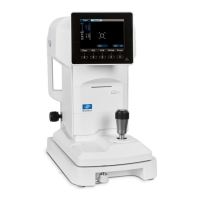1. Do not allow external light to directly penetrate the room.
2. Fluctuation of the measurement values may occur if the examinee looks something other than the
target. Urge the examinee to concentrate on the target set in front.
3. Talk to the examinee in a relaxed and friendly manner, so as to allay any fear or doubt they may
have.
4. Inappropriate height of the chinrest or the chair will cause the examinee fatigue. Adjust the (optional)
instrumental table to establish the most comfortable and convenient position for the examinee.
5. When the eyelash or eyelid interfere measurement, an error will occur in the measurement.
Urge the examinee to keep his/her eye open wider.
6. Tear residue or eye mucus, etc. trapped on the corneal surface may cause measurement errors.
Check the surface with the LCD monitor, and if you see something moving when the examinee blinks,
remove it before measurement.
7. When the pupil of the target eye is smaller than the minimum measurable pupil diameter, the device
cannot take measurements correctly.
If it is difficult to take measurements because the pupil is too small, darken the surroundings (room)
or the target to allow the pupil to dilate as much as possible.
8. If the examinee moves his/her head during the measurement, AXIS value will be adversely affected.
Ask him/her to maintain a correct posture.

